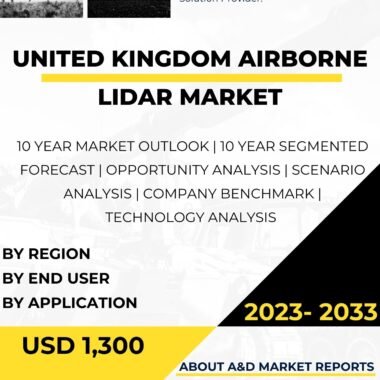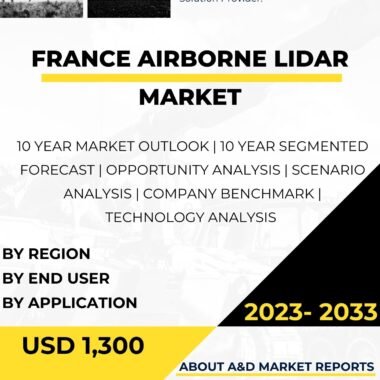Description
The Australia Airborne LiDAR (Light Detection and Ranging) Market is a rapidly growing and technologically advanced sector that holds immense significance in enhancing the country’s geospatial capabilities and supporting various industries, including defense, agriculture, forestry, and environmental monitoring. Airborne LiDAR technology uses laser pulses to measure distances to the Earth’s surface, creating high-resolution 3D point cloud models of the terrain and objects below. As a geographically diverse nation with vast and rugged landscapes, Australia recognizes the strategic importance of investing in cutting-edge Airborne LiDAR solutions. This article provides a comprehensive analysis of the Australia Airborne LiDAR Market, covering its current state, key drivers, challenges, applications, technological advancements, and growth prospects.
The Australia Airborne LiDAR Market has witnessed substantial growth due to the country’s strategic emphasis on enhancing its geospatial capabilities for a range of applications. Airborne LiDAR technology offers significant advantages over traditional surveying methods, such as rapid data acquisition, high accuracy, and the ability to penetrate dense vegetation. By utilizing Airborne LiDAR, Australia can efficiently map and analyze its vast and challenging terrain, supporting various industries and improving decision-making processes.
One of the key drivers behind the market’s prominence is the increasing demand for high-quality geospatial data for various applications. In the defense sector, Airborne LiDAR plays a critical role in supporting military operations, mission planning, and terrain analysis. LiDAR-derived 3D models enable the Australian Defense Force (ADF) to enhance situational awareness, plan routes, and assess the suitability of landing zones for aerial operations.
Moreover, the Australia Airborne LiDAR Market is driven by the country’s commitment to improving disaster management and emergency response capabilities. Airborne LiDAR technology facilitates the rapid mapping of disaster-affected areas, such as bushfire-affected regions, providing valuable information for damage assessment, search and rescue efforts, and post-disaster recovery planning.
The market’s growth is also influenced by Australia’s interest in enhancing its agricultural and forestry management practices. Airborne LiDAR data can be utilized to map and monitor agricultural land, assess vegetation health, and optimize crop yields. In the forestry sector, LiDAR helps in accurate forest inventory, planning, and sustainable management of natural resources.
Furthermore, the Australia Airborne LiDAR Market is driven by the country’s focus on environmental monitoring and conservation. LiDAR technology enables the assessment of biodiversity, identification of habitat areas, and monitoring of vegetation changes over time. This information is critical for understanding environmental trends, supporting conservation efforts, and preserving Australia’s unique ecosystems.
The Australia Airborne LiDAR Market finds diverse applications across various industries, each contributing to the country’s overall geospatial capabilities. In the infrastructure sector, LiDAR data is used for urban planning, transportation management, and civil engineering projects. LiDAR-derived elevation models support flood mapping, drainage analysis, and infrastructure development, enhancing urban resilience and public safety.
Furthermore, the Australia Airborne LiDAR Market plays a crucial role in supporting mineral exploration and resource management. LiDAR data assists in geological mapping, identifying potential mineral deposits, and planning resource extraction activities, contributing to Australia’s mining industry and economic growth.
Moreover, Airborne LiDAR technology is instrumental in supporting land and coastal management efforts. LiDAR data aids in coastline monitoring, erosion analysis, and land-use planning, helping to address the challenges posed by climate change and coastal development.
Additionally, the Australia Airborne LiDAR Market serves as a key component of the country’s research and scientific endeavors. LiDAR data supports academic research, environmental studies, and scientific investigations, contributing to advancements in various disciplines, including geography, geology, and ecology.
Despite the market’s growth and potential, the Australia Airborne LiDAR Market also faces certain challenges. One significant challenge is the need for specialized expertise and infrastructure to acquire and process LiDAR data effectively. Deploying airborne LiDAR systems requires skilled personnel, advanced sensors, and data processing capabilities, which can be resource-intensive.
Moreover, addressing the issue of data interoperability and standardization is crucial for optimizing the use of LiDAR data across different industries and sectors. Standardizing data formats and metadata can enhance data sharing, integration, and collaboration among various stakeholders.
Additionally, ensuring data security and privacy is essential when acquiring and utilizing LiDAR data for defense and other sensitive applications. Implementing robust data protection measures and complying with privacy regulations are essential to safeguard sensitive information.
Looking ahead, the Australia Airborne LiDAR Market is expected to witness continued growth and advancements. As the country seeks to enhance its geospatial capabilities and support various industries with high-quality data, the demand for cutting-edge Airborne LiDAR solutions will remain strong. Continued investment in research and development, collaboration between the government and industry stakeholders, and a focus on addressing technical challenges will drive advancements in LiDAR technology and applications.
In conclusion, the Australia Airborne LiDAR Market plays a critical role in enhancing the country’s geospatial capabilities, providing advanced 3D mapping and data analysis solutions for defense, agriculture, forestry, environmental monitoring, and other sectors. Airborne LiDAR technology enables Australia to efficiently map its diverse and challenging terrain, supporting a range of applications from disaster management to infrastructure planning. The market’s growth is driven by Australia’s strategic focus on adopting advanced geospatial technologies, fostering innovation within its defense industry, and supporting sustainable development. Addressing challenges related to expertise, data interoperability, and data security will be key to unlocking the full potential of Airborne LiDAR in enhancing Australia’s geospatial capabilities and supporting its national development objectives.




